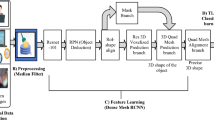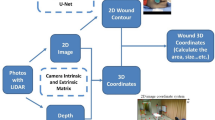Abstract
Accurate evaluation of burn degree is a key step in the treatment of burn patients. The body surface area of burn area is the main basis to evaluate the degree of burn. To estimate the burn area timely and accurately is the basis of providing correct infusion volume for patients and determining further treatment measures. Therefore, it is necessary to study a fast and effective method to calculate the area of human body burn. For large-area burn patients, accurate fluid replenishment in shock period plays an important role in the maintenance of vital signs and wound healing, and the estimation of burn body surface area is the basis for calculating fluid replenishment in shock period. As an important branch of computer vision, binocular stereo vision has penetrated into many fields of production and life, which is a hot topic in computer application. Binocular stereo vision technology is based on the theory of parallax, which uses binocular camera to collect the left and right views of the measured objects. The paper proposes the binocular vision uses stereo matching algorithm to calculate the position deviation between two images, so as to obtain the 3D geometric information of the object. Based on this, this paper uses binocular vision technology and capsule network model to build a medical burn area evaluation model. The experimental results show that the method proposed in this paper can effectively locate the burn area and image processing.


























Similar content being viewed by others
Availability of data and materials
We can provide the data.
References
Bignone F, Henricsson O, Fua P et al (1996) Automatic extraction of generic house roofs from high resolution aerial imagery. In: Proceedings of the 4th European conference on computer vision. Springer, Cambridge, United Kingdom, pp 85–96
Changjun Y (2012) Abdominal CT image segmentation and 3D visualization based on energy minimization [Dissertation]. Shanghai Jiaotong University
Chen Q, Zhang G, Yang X, Li S, Li Y, Wang HH (2018) Single image shadow detection and removal based on feature fusion and multiple dictionary learning. Multimed Tools Appl 77(14):18601–18624
Chengbo Yu, Diane Xiong (2018) Study on finger vein recognition based on capsule network. Appl Electron Technol 44(10):21–24
Choi C, Esposito C, Wang H, Liu Z, Choi J (2018) Intelligent power equipment management based on distributed context-aware inference in smart cities. IEEE Commun Mag 56(7):212–217
Dong H, Zheng L, Yu P, Jiang Q, Wu Y, Huang C, Yin B (2020) Characterization and application of lignin-carbohydrate complexes from lignocellulosic materials as antioxidant for scavenging in vitro and in vivo reactive oxygen species. ACS Sustain Chem Eng 8:256–266
Huang C, Wang X, Liang C, Jiang X, Yang G, Xu J, Yong Q (2019a) A sustainable process for procuring biologically active fractions of high-purity xylooligosaccharides and water-soluble lignin from Moso bamboo prehydrolyzate. Biotechnol Biofuels 12(1):189
Huang C, Lin W, Lai C, Li X, Jin Y, Yong Q (2019b) Coupling the post-extraction process to remove residual lignin and alter the recalcitrant structures for improving the enzymatic digestibility of acid-pretreated bamboo residues. Bioresour Technol 285:121355
Huimin Y (2005) 3D contour measurement based on time phase unwrapping. Sichuan University
Jelodar H, Wang Y, Yuan C, Feng X, Jiang X, Li Y, Zhao L (2019) Latent Dirichlet Allocation (LDA) and topic modeling: models, applications, a survey. Multimed Tools Appl 78(11):15169–15211
Jiao J, Han Y, Fischer-Hwang I, Weissman T (2019) Estimating the fundamental limits is easier than achieving the fundamental limits. IEEE Trans Inf Theory 65(10):6704–6715
Kolmogorov V, Zabih R (2001) Computing visual correspondence with occlusions using graph cuts. In: ICCV 2001 proceedings eighth IEEE international conference on computer vision, vol 2. IEEE, pp 508–515
Krizhevsky A, Sutskever I, Hinton GE (2012) Imagenet classification with deep convolutional neural networks. In: Advances in neural information processing systems, pp 1097–1105
Le Cun Y, Bottou L, Bengio Y et al (1998) Gradient-based learning applied to document recognition. Proc IEEE 86(11):2278–2324
Li X, Li D, Peng L, Zhou H, Chen D, Zhang Y, Xie L (2019) Color and depth image registration algorithm based on multi-vector-fields constraints. Multimed Tools Appl 78(17):24301–24319
Lin C, Lu W, Huang X, Liu K, Sun W, Lin H, Tan Z (2019) Copy-move forgery detection using combined features and transitive matching. Multimed Tools Appl 78(21):30081–30096
Lukic V, Brüggen M, Mingo B, Croston JH, Kasieczka G, Best PN (2019) Morphological classification of radio galaxies: capsule networks versus convolutional neural networks. Mon Not R Astron Soc 487(2):1729–1744
Marr D, Nishihara HK (1978) Representation and recognition of the spatial organization of three-dimensional shapes. Proc R Soc Lond 200(1140):269–294
Medioni G, Nevatia R (1985) Segment-based stereo matching. Computer Vis Graph Image Process 31(1):2–18
Pavlichin DS, Jiao J, Weissman T (2019) Approximate profile maximum likelihood. J Mach Learn Res 20(122):1–55
Piciarelli C, Mishra P, Foresti GL (2019) Image anomaly detection with capsule networks and imbalanced datasets. In: International conference on image analysis and processing. Springer, Cham, pp 257–267
Que S, Awuah-Offei K, Demirel A, Wang L, Demirel N, Chen Y (2019) Comparative study of factors affecting public acceptance of mining projects: Evidence from USA. China and Turkey. J Clean Prod 237:117634
Schmid K, Tomic T, Ruess F, et al (2014) Stereo vision based indoor/outdoor navigation for flying robots. In: IEEE/RSJ international conference on intelligent robots and systems. IEEE, pp 3955–3962
Thakur S, Singh AK, Ghrera SP, Elhoseny M (2019) Multi-layer security of medical data through watermarking and chaotic encryption for tele-health applications. Multimed Tools Appl 78(3):3457–3470
Vizilter Y, Zheltov S (2014) Similarity measures and comparison metrics for image shapes. J Comput Syst Sci Int 53(4):542–555
Wallace AB (1951) The exposure treatment of burns. Lancet 257(6653):501–504
Wang J, Wang X, Liu F et al (2014) Modeling of binocular stereo vision for remote coordinate measurement and fast calibration. Opt Lasers Eng 54(1):269–274
Weibing Chen (2010) Comparison of matching performance of several image similarity measures. Comput Appl 30(1):98–111
Wu B (2006) Research on local mapping technology of 3D Terrain Based on triangle net model [Dissertation]. Shenyang University of technology
Xiong Y, Berisha V, Chakrabarti C (2019) Residual + Capsule Networks (ResCap) for simultaneous single-channel overlapped keyword recognition. In: Proceedings of the annual conference of the international speech communication association, INTERSPEECH, vol 2019, pp 3337–3341
Yandong L, Zongbo H, Hang L (2016) Review of convolutional neural network research. Comput Appl 36(9):2508–2515
Yi Xu, Jun Zhou, Yuanhua Zhou (2003) Phase matching based on wavelet and dynamic programming. J Shanghai Jiaotong Univ 37(3):388–392
Yingying Su, Lianjuan Han, Jianan Wang, Huimin Wang (2019) Quantum-behaved RS-PSO-LSSVM method for quality prediction in parts production processes. Concurr Computat Pract Exp 9:e5522
Zhang C, Koishida K (2017) End-to-end text-independent speaker verification with triplet loss on short utterances. In: Conference of the international speech communication association, pp 1487–1491
Zhang S, Wang H, Huang W, You Z (2018a) Plant diseased leaf segmentation and recognition by fusion of superpixel, K-means and PHOG. Optik 157:866–872
Zhang J, Williams SO, Wang H (2018b) Intelligent computing system based on pattern recognition and data mining algorithms. Sustain Comput Inform Syst 20:192–202
Zhao Y, Birdal T, Deng H, Tombari F (2019) 3D point capsule networks. In: Proceedings of the IEEE conference on computer vision and pattern recognition, pp 1009–1018
Acknowledgement
The research presented in this paper was supported by the Funds of Science and Technology Research of Guangdong Province (Grant: 2017A040403070); High-Level Hospital Construction Research Project of Maoming People’s Hospital; and the Industry–University–Research Project of Maoming City (2019).
Author information
Authors and Affiliations
Contributions
All authors take part in the discussion of the work described in this paper. All the authors have the same contribution.
Corresponding author
Ethics declarations
Conflict of interest
The authors declare no conflicts of interest regarding publishing this paper.
Consent for publication
Not applicable.
Ethics approval and consent to participate
Not applicable.
Additional information
Communicated by V. Loia.
Publisher's Note
Springer Nature remains neutral with regard to jurisdictional claims in published maps and institutional affiliations.
Rights and permissions
About this article
Cite this article
Wu, X., Chen, H., Wu, X. et al. Simultaneous localization and mapping of medical burn areas based on binocular vision and capsule networks. Soft Comput 24, 18155–18171 (2020). https://doi.org/10.1007/s00500-020-05067-4
Published:
Issue Date:
DOI: https://doi.org/10.1007/s00500-020-05067-4




